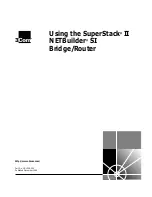
Chapter 16
| Spanning Tree Commands
– 372 –
Default Setting
rstp
Command Mode
Global Configuration
Command Usage
◆
Spanning Tree Protocol
This option uses RSTP set to STP forced compatibility mode. It uses RSTP for the
internal state machine, but sends only 802.1D BPDUs. This creates one
spanning tree instance for the entire network. If multiple VLANs are
implemented on a network, the path between specific VLAN members may be
inadvertently disabled to prevent network loops, thus isolating group
members. When operating multiple VLANs, we recommend selecting the MSTP
option.
◆
Rapid Spanning Tree Protocol
RSTP supports connections to either STP or RSTP nodes by monitoring the
incoming protocol messages and dynamically adjusting the type of protocol
messages the RSTP node transmits, as described below:
■
STP Mode – If the switch receives an 802.1D BPDU after a port’s migration
delay timer expires, the switch assumes it is connected to an 802.1D bridge
and starts using only 802.1D BPDUs.
■
RSTP Mode – If RSTP is using 802.1D BPDUs on a port and receives an RSTP
BPDU after the migration delay expires, RSTP restarts the migration delay
timer and begins using RSTP BPDUs on that port.
◆
Multiple Spanning Tree Protocol
■
To allow multiple spanning trees to operate over the network, you must
configure a related set of bridges with the same MSTP configuration,
allowing them to participate in a specific set of spanning tree instances.
■
A spanning tree instance can exist only on bridges that have compatible
VLAN instance assignments.
■
Be careful when switching between spanning tree modes. Changing
modes stops all spanning-tree instances for the previous mode and restarts
the system in the new mode, temporarily disrupting user traffic.
Example
The following example configures the switch to use Rapid Spanning Tree:
Console(config)#spanning-tree mode rstp
Console(config)#
Summary of Contents for EX-3524
Page 2: ......
Page 28: ...Figures 28 ...
Page 34: ...Section I Getting Started 34 ...
Page 58: ...Chapter 1 Initial Switch Configuration Setting the System Clock 58 ...
Page 72: ...Chapter 2 Using the Command Line Interface CLI Command Groups 72 ...
Page 156: ...Chapter 5 SNMP Commands Notification Log Commands 156 ...
Page 164: ...Chapter 6 Remote Monitoring Commands 164 ...
Page 218: ...Chapter 7 Authentication Commands Management IP Filter 218 ...
Page 268: ...Chapter 8 General Security Measures Port based Traffic Segmentation 268 ...
Page 292: ...Chapter 9 Access Control Lists ACL Information 292 ...
Page 312: ...Chapter 10 Interface Commands Power Savings 312 ...
Page 324: ...Chapter 11 Link Aggregation Commands Trunk Status Display Commands 324 ...
Page 366: ...Chapter 15 Address Table Commands 366 ...
Page 428: ...Chapter 17 VLAN Commands Configuring Voice VLANs 428 ...
Page 572: ...Chapter 25 IP Interface Commands IPv6 Interface 572 ...
Page 578: ...Section I Appendices 578 ...
















































